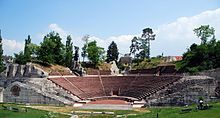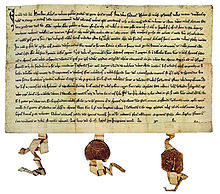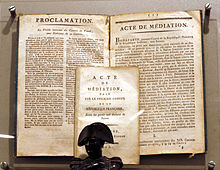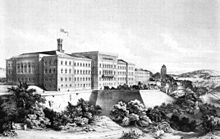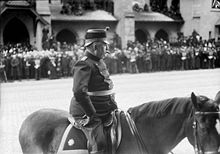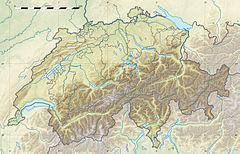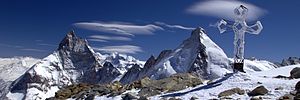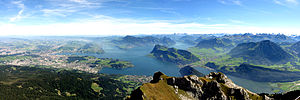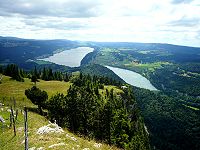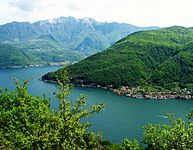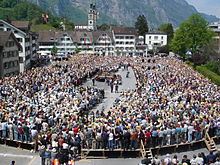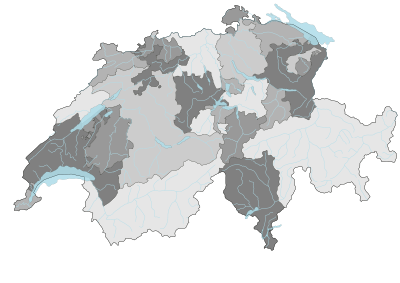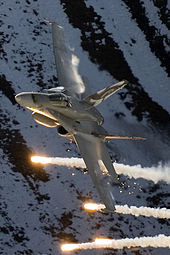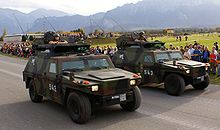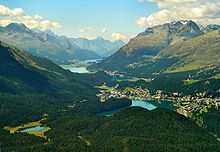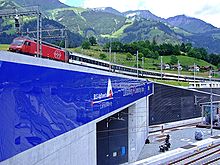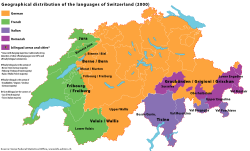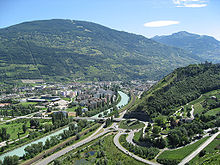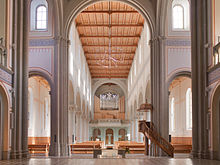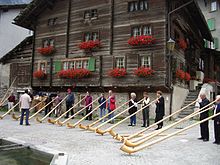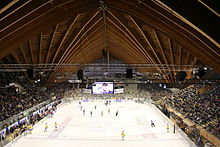
Switzerland
About this schools Wikipedia selection
SOS Children has tried to make Wikipedia content more accessible by this schools selection. To compare sponsorship charities this is the best sponsorship link.
|
||||||
| Motto: (traditional) " Unus pro omnibus, omnes pro uno" (Latin) "One for all, all for one" |
||||||
| Anthem: Swiss Psalm | ||||||
| Capital | None ( de jure), Bern ( de facto) 46°57′N 7°27′E |
|||||
| Largest city | Zurich | |||||
| Official languages |
||||||
| Demonym | Swiss | |||||
| Government | Directorial federal republic with elements of direct democracy | |||||
| - | Federal Council |
|
||||
| - | Federal Chancellor | C. Casanova | ||||
| Legislature | Federal Assembly | |||||
| - | Upper house | Council of States | ||||
| - | Lower house | National Council | ||||
| Independence | ||||||
| - | Foundation date | c. 1300 | ||||
| - | de facto | 22 September 1499 | ||||
| - | de jure | 24 October 1648 | ||||
| - | Restored | 7 August 1815 | ||||
| - | Federal state | 12 September 1848 | ||||
| Area | ||||||
| - | Total | 41,285 km2 ( 133rd) 15,940 sq mi |
||||
| - | Water (%) | 4.2 | ||||
| Population | ||||||
| - | 2012 estimate | 8,000,000 ( 96th) | ||||
| - | 2011 census | 7,954,700 | ||||
| - | Density | 188/km2 ( 65th) 477.4/sq mi |
||||
| GDP ( PPP) | 2012 estimate | |||||
| - | Total | $363.421 billion | ||||
| - | Per capita | $45,417 | ||||
| GDP (nominal) | 2012 estimate | |||||
| - | Total | $632.400 billion | ||||
| - | Per capita | $79,033 | ||||
| Gini (2009) | 33.7 medium |
|||||
| HDI (2013) | very high · 9th |
|||||
| Currency | Swiss franc ( CHF) |
|||||
| Time zone | CET ( UTC+1) | |||||
| - | Summer ( DST) | CEST ( UTC+2) | ||||
| Drives on the | right | |||||
| Calling code | +41 | |||||
| ISO 3166 code | CH | |||||
| Internet TLD | .ch | |||||
Switzerland (German: Schweiz [ˈʃvaɪts]; French: Suisse [sɥis]; Italian: Svizzera [ˈzvittseːra]; Romansh: Svizra [ˈʒviːtsrɐ] or [ˈʒviːtsʁːɐ]), officially the Swiss Confederation (Latin: Confoederatio Helvetica, hence its abbreviation CH), is a federal republic consisting of 26 cantons, with Bern as the seat of the federal authorities. The country is situated in western Europe, where it is bordered by Germany to the north, France to the west, Italy to the south, and Austria and Liechtenstein to the east.
Switzerland is a landlocked country geographically divided between the Alps, the Swiss Plateau and the Jura, spanning an area of 41,285 km2 (15,940 sq mi). While the Alps occupy the greater part of the territory, the Swiss population of approximately 8 million people is concentrated mostly on the Plateau, where the largest cities are to be found. Among them are the two global cities and economic centres - Zurich and Geneva. The Swiss Confederation has a long history of armed neutrality—it has not been in a state of war internationally since 1815—and did not join the United Nations until 2002. It pursues, however, an active foreign policy and is frequently involved in peace-building processes around the world. Switzerland is also the birthplace of the Red Cross and home to a large number of international organizations, including the second largest UN office. On the European level, it is a founding member of the European Free Trade Association and is part of the Schengen Area – although it is notably not a member of the European Union, nor the European Economic Area.
Switzerland is one of the richest countries in the world by per capita gross domestic product, and has the highest wealth per adult (financial and non-financial assets) of any country in the world. Zurich and Geneva have respectively been ranked as the cities with the second and eighth highest quality of life in the world. It has the world's nineteenth largest economy by nominal GDP and the thirty-sixth largest by purchasing power parity. It is the twentieth largest exporter and eighteenth largest importer of goods.
Switzerland comprises four main linguistic and cultural regions: German, French, Italian and Romansh. The Swiss, therefore, though predominantly German-speaking, do not form a nation in the sense of a common ethnic or linguistic identity. The strong sense of belonging to the country is founded on the common historical background, shared values ( federalism and direct democracy) and Alpine symbolism. The establishment of the Swiss Confederation is traditionally dated to 1 August 1291; Swiss National Day is celebrated on the anniversary.
Etymology
The English name Switzerland is a compound containing Switzer, an obsolete term for the Swiss, which was in use during the 16th to 19th centuries. The English adjective Swiss is a loan from French Suisse, also in use since the 16th century. The name Switzer is from the Alemannic Schwiizer, in origin an inhabitant of Schwyz and its associated territory, one of the Waldstätten cantons which formed the nucleus of the Old Swiss Confederacy. The name originates as an exonym, applied pars pro toto to the troops of the Confederacy. The Swiss themselves began to adopt the name for themselves after the Swabian War of 1499, used alongside the term for "Confederates", Eidgenossen, used since the 14th century.
The toponym Schwyz itself is first attested in 972, as Old High German Suittes, ultimately perhaps related to suedan "to burn", referring to the area of forest that was burned and cleared to build. The name was extended to the area dominated by the canton, and after the Swabian War of 1499 gradually came to be used for the entire Confederation. The Swiss German name of the country, Schwiiz, is homophonous to that of the canton and the settlement, but distinguished by the use of the definite article (d'Schwiiz for the Confederation, but simply Schwyz for the canton and the town).
The Latin name Confoederatio Helvetica was neologized and introduced gradually after the formation of the federal state in 1848, harking back to the Napoleonic Helvetic Republic, appearing on coins from 1879, inscribed on the Federal Palace in 1902 and after 1948 used in the official seal. It is derived from the name of the Helvetii, a Gaulish tribe living on the Swiss plateau before the Roman era. Helvetia appears as a national personification of the Swiss confederacy in the 17th century, with a 1672 play by Johann Caspar Weissenbach.
History
Switzerland has existed as a state in its present form since the adoption of the Swiss Federal Constitution in 1848. The precursors of Switzerland established a protective alliance at the end of the 13th century (1291), forming a loose confederation of states which persisted for centuries.
Early history
The oldest traces of hominid existence in Switzerland date back about 150,000 years. The oldest known farming settlements in Switzerland, which were found at Gächlingen, have been dated to around 5300 BC.
The earliest known cultural tribes of the area were members of the Hallstatt and La Tène cultures, named after the archaeological site of La Tène on the north side of Lake Neuchâtel. La Tène culture developed and flourished during the late Iron Age from around 450 BC, possibly under some influence from the Greek and Etruscan civilisations. One of the most important tribal groups in the Swiss region was the Helvetii. In 58 BC, at the Battle of Bibracte, Julius Caesar's armies defeated the Helvetii. In 15 BC, Tiberius, who was destined to be the second Roman emperor and his brother, Drusus, conquered the Alps, integrating them into the Roman Empire. The area occupied by the Helvetii—the namesakes of the later Confoederatio Helvetica—first became part of Rome's Gallia Belgica province and then of its Germania Superior province, while the eastern portion of modern Switzerland was integrated into the Roman province of Raetia.
In the Early Middle Ages, from the 4th century, the western extent of modern-day Switzerland was part of the territory of the Kings of the Burgundians. The Alemanni settled the Swiss plateau in the 5th century and the valleys of the Alps in the 8th century, forming Alemannia. Modern-day Switzerland was therefore then divided between the kingdoms of Alemannia and Burgundy. The entire region became part of the expanding Frankish Empire in the 6th century, following Clovis I's victory over the Alemanni at Tolbiac in 504 AD, and later Frankish domination of the Burgundians.
Throughout the rest of the 6th, 7th and 8th centuries the Swiss regions continued under Frankish hegemony ( Merovingian and Carolingian dynasties). But after its extension under Charlemagne, the Frankish empire was divided by the Treaty of Verdun in 843. The territories of present day Switzerland became divided into Middle Francia and East Francia until they were reunified under the Holy Roman Empire around 1000 AD.
By 1200, the Swiss plateau comprised the dominions of the houses of Savoy, Zähringer, Habsburg, and Kyburg. Some regions ( Uri, Schwyz, Unterwalden, later known as Waldstätten) were accorded the Imperial immediacy to grant the empire direct control over the mountain passes. When the Kyburg dynasty fell in 1264 AD, the Habsburgs under King Rudolph I (Holy Roman Emperor in 1273) extended their territory to the eastern Swiss plateau.
Old Swiss Confederacy
The Old Swiss Confederacy was an alliance among the valley communities of the central Alps. The Confederacy facilitated management of common interests and ensured peace on the important mountain trade routes. The Federal Charter of 1291 agreed between the rural communes of Uri, Schwyz, and Unterwalden is considered the confederacy's founding document, even though similar alliances are likely to have existed decades earlier.
By 1353, the three original cantons had joined with the cantons of Glarus and Zug and the Lucerne, Zurich and Bern city states to form the "Old Confederacy" of eight states that existed until the end of the 15th century. The expansion led to increased power and wealth for the federation. By 1460, the confederates controlled most of the territory south and west of the Rhine to the Alps and the Jura mountains, particularly after victories against the Habsburgs ( Battle of Sempach, Battle of Näfels), over Charles the Bold of Burgundy during the 1470s, and the success of the Swiss mercenaries. The Swiss victory in the Swabian War against the Swabian League of Emperor Maximilian I in 1499 amounted to de facto independence within the Holy Roman Empire.
The Old Swiss Confederacy had acquired a reputation of invincibility during these earlier wars, but expansion of the federation suffered a setback in 1515 with the Swiss defeat in the Battle of Marignano. This ended the so-called "heroic" epoch of Swiss history. The success of Zwingli's Reformation in some cantons led to inter-cantonal religious conflicts in 1529 and 1531 ( Wars of Kappel). It was not until more than one hundred years after these internal wars that, in 1648, under the Peace of Westphalia, European countries recognized Switzerland's independence from the Holy Roman Empire and its neutrality.
During the Early Modern period of Swiss history, the growing authoritarianism of the patriciate families combined with a financial crisis in the wake of the Thirty Years' War led to the Swiss peasant war of 1653. In the background to this struggle, the conflict between Catholic and Protestant cantons persisted, erupting in further violence at the Battles of Villmergen in 1656 and 1712.
Napoleonic era
In 1798, the revolutionary French government conquered Switzerland and imposed a new unified constitution. This centralised the government of the country and effectively abolished the cantons and Mülhausen and Valtellina valley separated from Switzerland. The new regime, known as the Helvetic Republic, was highly unpopular. It had been imposed by a foreign invading army and destroyed centuries of tradition, making Switzerland nothing more than a French satellite state. The fierce French suppression of the Nidwalden Revolt in September 1798 was an example of the oppressive presence of the French Army and the local population's resistance to the occupation.
When war broke out between France and its rivals, Russian and Austrian forces invaded Switzerland. The Swiss refused to fight alongside the French in the name of the Helvetic Republic. In 1803 Napoleon organised a meeting of the leading Swiss politicians from both sides in Paris. The result was the Act of Mediation which largely restored Swiss autonomy and introduced a Confederation of 19 cantons. Henceforth much of Swiss politics would concern balancing the cantons' tradition of self-rule with the need for a central government.
In 1815 the Congress of Vienna fully re-established Swiss independence and the European powers agreed to permanently recognise Swiss neutrality. Swiss troops still served foreign governments until 1860 when they fought in the Siege of Gaeta. The treaty also allowed Switzerland to increase its territory, with the admission of the cantons of Valais, Neuchâtel and Geneva. Switzerland's borders have not changed since.
Federal state
The restoration of the power to the patriciate was only temporary. After a period of unrest with repeated violent clashes such as the Züriputsch of 1839, civil war broke out in 1847 when some of the Catholic cantons tried to set up a separate alliance (the Sonderbundskrieg). The war lasted for less than a month, causing fewer than 100 casualties, most of which were through friendly fire. However minor the Sonderbundskrieg seems to be when compared with other European riots and wars in the 19th century, it nevertheless had a major impact on both the psychology and the society of the Swiss and of Switzerland.
The war convinced most Swiss of the need for unity and strength towards its European neighbours. Swiss people from all strata of society, whether Catholic, Protestant, or from the liberal or conservative current, realised that the cantons would profit more if their economic and religious interests were merged.
Thus, while the rest of Europe was plagued by revolutionary uprisings, the Swiss drew up a constitution which provided for a federal layout, much of it inspired by the American example. This constitution provided for a central authority while leaving the cantons the right to self-government on local issues. Giving credit to those who favoured the power of the cantons (the Sonderbund Kantone), the national assembly was divided between an upper house (the Swiss Council of States, 2 representatives per canton) and a lower house (the National Council of Switzerland, representatives elected from across the country). Referenda were made mandatory for any amendment of this constitution.
A system of single weights and measures was introduced and in 1850 the Swiss franc became the Swiss single currency. Article 11 of the constitution forbade sending troops to serve abroad, though the Swiss were still obliged to serve Francis II of the Two Sicilies with Swiss Guards present at the Siege of Gaeta in 1860, marking the end of foreign service.
An important clause of the constitution was that it could be re-written completely if this was deemed necessary, thus enabling it to evolve as a whole rather than being modified one amendment at a time.
This need soon proved itself when the rise in population and the Industrial Revolution that followed led to calls to modify the constitution accordingly. An early draft was rejected by the population in 1872 but modifications led to its acceptance in 1874. It introduced the facultative referendum for laws at the federal level. It also established federal responsibility for defense, trade, and legal matters.
In 1891, the constitution was revised with unusually strong elements of direct democracy, which remain unique even today.
Modern history
Switzerland was not invaded during either of the world wars. During World War I, Switzerland was home to Vladimir Illych Ulyanov (Vladimir Lenin) and he remained there until 1917. Swiss neutrality was seriously questioned by the Grimm–Hoffmann Affair in 1917, but it was short-lived. In 1920, Switzerland joined the League of Nations, which was based in Geneva, on the condition that it was exempt from any military requirements.
During World War II, detailed invasion plans were drawn up by the Germans, but Switzerland was never attacked. Switzerland was able to remain independent through a combination of military deterrence, concessions to Germany, and good fortune as larger events during the war delayed an invasion. Under General Henri Guisan, a massive mobilisation of militia forces was ordered. The Swiss military strategy was changed from one of static defence at the borders to protect the economic heartland, to one of organised long-term attrition and withdrawal to strong, well-stockpiled positions high in the Alps known as the Reduit. Switzerland was an important base for espionage by both sides in the conflict and often mediated communications between the Axis and Allied powers.
Switzerland's trade was blockaded by both the Allies and by the Axis. Economic cooperation and extension of credit to the Third Reich varied according to the perceived likelihood of invasion and the availability of other trading partners. Concessions reached a peak after a crucial rail link through Vichy France was severed in 1942, leaving Switzerland completely surrounded by the Axis. Over the course of the war, Switzerland interned over 300,000 refugees and the International Red Cross, based in Geneva, played an important part during the conflict. Strict immigration and asylum policies as well as the financial relationships with Nazi Germany raised controversy, but not until the end of the 20th century.
During the war, the Swiss Air Force engaged aircraft of both sides, shooting down 11 intruding Luftwaffe planes in May and June 1940, then forcing down other intruders after a change of policy following threats from Germany. Over 100 Allied bombers and their crews were interned during the war. During 1944–45, Allied bombers mistakenly bombed a few places in Switzerland, among which were the cities of Schaffhausen, Basel and Zurich.
After the war, the Swiss government exported credits through the charitable fund known as the Schweizerspende and also donated to the Marshall Plan to help Europe's recovery, efforts that ultimately benefited the Swiss economy.
Women were granted the right to vote in the first Swiss cantons in 1959, at the federal level in 1971 and, after resistance, in the last canton Appenzell Innerrhoden (one of only two remaining Landsgemeinde) in 1990. After suffrage at the federal level, women quickly rose in political significance, with the first woman on the seven member Federal Council executive being Elisabeth Kopp, who served from 1984–1989, and the first female president being Ruth Dreifuss in 1999.
Switzerland joined the Council of Europe in 1963. In 1979 areas from the canton of Bern attained independence from the Bernese, forming the new canton of Jura. On 18 April 1999 the Swiss population and the cantons voted in favour of a completely revised federal constitution.
In 2002 Switzerland became a full member of the United Nations, leaving the Vatican City as the last widely recognised state without full UN membership. Switzerland is a founding member of the EFTA, but is not a member of the European Economic Area. An application for membership in the European Union was sent in May 1992, but not advanced since the EEA was rejected in December 1992 when Switzerland was the only country to launch a referendum on the EEA. There have since been several referenda on the EU issue; due to a mixed reaction from the population the membership application has been frozen. Nonetheless, Swiss law is gradually being adjusted to conform with that of the EU, and the government has signed a number of bilateral agreements with the European Union. Switzerland, together with Liechtenstein, has been completely surrounded by the EU since Austria's membership in 1995. On 5 June 2005, Swiss voters agreed by a 55% majority to join the Schengen treaty, a result that was regarded by EU commentators as a sign of support by Switzerland, a country that is traditionally perceived as independent and reluctant to enter supranational bodies.
Geography
Extending across the north and south side of the Alps in west-central Europe, Switzerland encompasses a great diversity of landscapes and climates on a limited area of 41,285 square kilometres (15,940 sq mi). The population is about 7.9 million, resulting in an average population density of around 190 people per square kilometre (485/sq mi). The more mountainous southern half of the country is far more sparsely populated than the northern half. In the largest Canton of Graubünden, lying entirely in the Alps, population density falls to 27 /km² (70 /sq mi).
Switzerland lies between latitudes 45° and 48° N, and longitudes 5° and 11° E. It contains three basic topographical areas: the Swiss Alps to the south, the Swiss plateau or middleland, and the Jura mountains on the north. The Alps are a high mountain range running across the central-south of the country, comprising about 60% of the country's total area. Among the high valleys of the Swiss Alps many glaciers are found, totalling an area of 1,063 square kilometres. From these originate the headwaters of several major rivers, such as the Rhine, Inn, Ticino and Rhone, which flow in the four cardinal directions into the whole of Europe. The hydrographic network includes several of the largest bodies of freshwater in Central and Western Europe, among which are included Lake Geneva, Lake Constance and Lake Maggiore. Switzerland has more than 1500 lakes, and contains 6% of Europe's stock of fresh water. Lakes and glaciers cover about 6% of the national territory.
About a hundred of Switzerland's mountain peaks are close to or higher than 4,000 metres (13,000 ft). At 4,634 m (15,203 ft), Monte Rosa is the highest, although the Matterhorn (4,478 m or 14,692 ft) is probably the most famous. Both are located within the Pennine Alps in the canton of Valais. The section of the Bernese Alps above the deep glacial Lauterbrunnen valley, containing 72 waterfalls, is well known for the Jungfrau (4,158 m or 13,642 ft) and Eiger, and the many picturesque valleys in the region. In the southeast the long Engadin Valley, encompassing the St. Moritz area in canton Graubünden, is also well known; the highest peak in the neighbouring Bernina Alps is Piz Bernina (4,049 m or 13,284 ft).
The more populous northern part of the country, comprising about 30% of the country's total area, is called the Middle Land. It has greater open and hilly landscapes, partly forested, partly open pastures, usually with grazing herds, or vegetables and fruit fields, but it is still hilly. There are large lakes found here and the biggest Swiss cities are in this area of the country. The largest lake is Lake Geneva (also called Lac Léman in French), in western Switzerland. The Rhone River is both the main input and output of Lake Geneva.
Climate
The Swiss climate is generally temperate, but can vary greatly between the localities, from glacial conditions on the mountaintops to the often pleasant near Mediterranean climate at Switzerland's southern tip. There are some valley areas in the southern part of Switzerland where some cold-hardy palm trees are found. Summers tend to be warm and humid at times with periodic rainfall so they are ideal for pastures and grazing. The less humid winters in the mountains may see long intervals of stable conditions for weeks, while the lower lands tend to suffer from inversion, during these periods, thus seeing no sun for weeks.
A weather phenomenon known as the föhn (with an identical effect to the chinook wind) can occur at all times of the year and is characterised by an unexpectedly warm wind, bringing air of very low relative humidity to the north of the Alps during rainfall periods on the southern face of the Alps. This works both ways across the alps but is more efficient if blowing from the south due to the steeper step for oncoming wind from the south. Valleys running south to north trigger the best effect. The driest conditions persist in all inner alpine valleys that receive less rain because arriving clouds lose a lot of their content while crossing the mountains before reaching these areas. Large alpine areas such as Graubünden remain drier than pre-alpine areas and as in the main valley of the Valais wine grapes are grown there.
The wettest conditions persist in the high Alps and in the Ticino canton which has much sun yet heavy bursts of rain from time to time. Precipitation tends to be spread moderately throughout the year with a peak in summer. Autumn is the driest season, winter receives less precipitation than summer, yet the weather patterns in Switzerland are not in a stable climate system and can be variable from year to year with no strict and predictable periods.
Environment
Switzerland's ecosystems can be particularly fragile, because of the many delicate valleys separated by high mountains, often forming unique ecologies. The mountainous regions themselves are also vulnerable, with a rich range of plants not found at other altitudes, and experience some pressure from visitors and grazing. The climatic, geological and topographical conditions of the alpine region make for a very fragile ecosystem that is particularly sensitive to climate change.
Politics
The Federal Constitution adopted in 1848 is the legal foundation of the modern federal state. It is among the oldest constitutions in the world. A new Constitution was adopted in 1999, but did not introduce notable changes to the federal structure. It outlines basic and political rights of individuals and citizen participation in public affairs, divides the powers between the Confederation and the cantons and defines federal jurisdiction and authority. There are three main governing bodies on the federal level: the bicameral parliament (legislative), the Federal Council (executive) and the Federal Court (judicial).
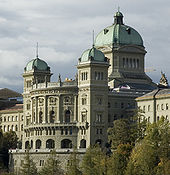
The Swiss Parliament consists of two houses: the Council of States which has 46 representatives (two from each canton and one from each half-canton) who are elected under a system determined by each canton, and the National Council, which consists of 200 members who are elected under a system of proportional representation, depending on the population of each canton. Members of both houses serve for 4 years. When both houses are in joint session, they are known collectively as the Federal Assembly. Through referendums, citizens may challenge any law passed by parliament and through initiatives, introduce amendments to the federal constitution, thus making Switzerland a direct democracy.
The Federal Council constitutes the federal government, directs the federal administration and serves as collective Head of State. It is a collegial body of seven members, elected for a four-year mandate by the Federal Assembly which also exercises oversight over the Council. The President of the Confederation is elected by the Assembly from among the seven members, traditionally in rotation and for a one-year term; the President chairs the government and assumes representative functions. However, the president is a primus inter pares with no additional powers, and remains the head of a department within the administration.
The Swiss government has been a coalition of the four major political parties since 1959, each party having a number of seats that roughly reflects its share of electorate and representation in the federal parliament. The classic distribution of 2 CVP/PDC, 2 SPS/PSS, 2 FDP/PRD and 1 SVP/UDC as it stood from 1959 to 2003 was known as the " magic formula". Following the 2011 Federal Council elections, the seven seats in the Federal Council were distributed as follows:
- 1 seat for the Christian Democratic People's Party (CVP/PDC),
- 1 seat for the Conservative Democratic Party (BDP/PBD),
- 2 seats for the Free Democratic Party (FDP/PRD),
- 2 seats for the Social Democratic Party (SPS/PSS),
- 1 seat for the Swiss People's Party (SVP/UDC).
The function of the Federal Supreme Court is to hear appeals against rulings of cantonal or federal courts. The judges are elected by the Federal Assembly for six-year terms.
Direct democracy
Swiss citizens are subject to three legal jurisdictions: the commune, canton and federal levels. The 1848 federal constitution defines a system of direct democracy (sometimes called half-direct or representative direct democracy since it is aided by the more commonplace institutions of a representative democracy). The instruments of Swiss direct democracy at the federal level, known as civic rights (Volksrechte, droits civiques), include the right to submit a constitutional initiative and a referendum, both of which may overturn parliamentary decisions.
By calling a federal referendum a group of citizens may challenge a law that has been passed by Parliament, if they can gather 50,000 signatures against the law within 100 days. If so, a national vote is scheduled where voters decide by a simple majority whether to accept or reject the law. Eight cantons together can also call a referendum on a federal law.
Similarly, the federal constitutional initiative allows citizens to put a constitutional amendment to a national vote, if they can get 100,000 voters to sign the proposed amendment within 18 months. Parliament can supplement the proposed amendment with a counter-proposal, with voters having to indicate a preference on the ballot in case both proposals are accepted. Constitutional amendments, whether introduced by initiative or in Parliament, must be accepted by a double majority of both the national popular vote and a majority of the cantonal popular votes.
Administrative divisions
The Swiss Confederation consists of 26 cantons:
| Canton | Capital | Canton | Capital | ||
|---|---|---|---|---|---|
| Aargau | Aarau | * Nidwalden | Stans | ||
| * Appenzell Ausserrhoden | Herisau | * Obwalden | Sarnen | ||
| * Appenzell Innerrhoden | Appenzell | Schaffhausen | Schaffhausen | ||
| * Basel-Landschaft | Liestal | Schwyz | Schwyz | ||
| * Basel-Stadt | Basel | Solothurn | Solothurn | ||
| Bern | Bern | St. Gallen | St. Gallen | ||
| Fribourg | Fribourg | Thurgau | Frauenfeld | ||
| Geneva | Geneva | Ticino | Bellinzona | ||
| Glarus | Glarus | Uri | Altdorf | ||
| Graubünden | Chur | Valais | Sion | ||
| Jura | Delémont | Vaud | Lausanne | ||
| Lucerne | Lucerne | Zug | Zug | ||
| Neuchâtel | Neuchâtel | Zurich | Zurich | ||
*These half-cantons are represented by one councillor (instead of two) in the Council of States.
The cantons have a permanent constitutional status and, in comparison with the situation in other countries, a high degree of independence. Under the Federal Constitution, all 26 cantons are equal in status. Each canton has its own constitution, and its own parliament, government and courts. However, there are considerable differences between the individual cantons, most particularly in terms of population and geographical area. Their populations vary between 15,000 (Appenzell Innerrhoden) and 1,253,500 (Zurich), and their area between 37 km2 (14 sq mi) (Basel-Stadt) and 7,105 km2 (2,743 sq mi) (Graubünden). The Cantons comprise a total of 2,485 municipalities. Within Switzerland there are two enclaves: Büsingen belongs to Germany, Campione d'Italia belongs to Italy.
In a referendum held in the Austrian state of Vorarlberg on 11 May 1919, over 80% of those voting supported a proposal that the state should join the Swiss Confederation. However, this was prevented by the opposition of the Austrian Government, the Allies, Swiss liberals and non-German-speaking Swiss.
Foreign relations and international institutions
Traditionally, Switzerland avoids alliances that might entail military, political, or direct economic action and had been neutral since the end of its expansion in 1515. Its policy of neutrality was internationally recognised at the Congress of Vienna in 1815. Only in 2002 did Switzerland become a full member of the United Nations and it was the first state to join it by referendum. Switzerland maintains diplomatic relations with almost all countries and historically has served as an intermediary between other states. Switzerland is not a member of the European Union; the Swiss people have consistently rejected membership since the early 1990s.
An unusual number of international institutions have their seats in Switzerland, in part because of its policy of neutrality. Geneva is the birthplace of the Red Cross and Red Crescent Movement and the Geneva Conventions and, since 2006, hosts the United Nations Human Rights Council. Even though Switzerland is one of the most recent countries to have joined the United Nations, the Palace of Nations in Geneva is the second biggest centre for the United Nations after New York, and Switzerland was a founding member and home to the League of Nations.
Apart from the United Nations headquarters, the Swiss Confederation is host to many UN agencies, like the World Health Organization (WHO), the International Labour Organization ( ILO), the International Telecommunication Union ( ITU), the United Nations High Commissioner for Refugees ( UNHCR) and about 200 other international organisations, including the World Trade Organization. The annual meetings of the World Economic Forum in Davos bring together top international business and political leaders from Switzerland and foreign countries to discuss important issues facing the world, including health and the environment.
Furthermore, many sport federations and organisations are located throughout the country, such as the International Basketball Federation, in Geneva, the UEFA (Union of European Football Associations), in Nyon, the FIFA (International Federation of Association Football) and the International Ice Hockey Federation, in Zurich, the International Cycling Union, in Aigle, and the International Olympic Committee, in Lausanne.
Military
The Swiss Armed Forces, including the Land Forces and the Air Force, are composed of conscripts: professional soldiers constitute only about 5% of the military personnel, and all the rest are conscript male citizens aged from 20 to 34 (in special cases up to 50) years. Being a landlocked country, Switzerland has no navy; however, on lakes bordering neighbouring countries, armed military patrol boats are used. Swiss citizens are prohibited from serving in foreign armies, with the exception of the Swiss Guards of the Vatican, or if they are dual citizens of a foreign country and resident there.
The structure of the Swiss militia system stipulates that the soldiers keep their Army issued equipment, including all personal weapons, at home. Some organizations and political parties find this practice controversial but mainstream Swiss opinion is in favour of the system. Compulsory military service concerns all male Swiss citizens; women can serve voluntarily. Men usually receive military conscription orders for training at the age of 19. About two thirds of the young Swiss are found suited for service; for those found unsuited, various forms of alternative service exist. Annually, approximately 20,000 persons are trained in recruit centres for a duration from 18 to 21 weeks. The reform "Army XXI" was adopted by popular vote in 2003, it replaced the previous model "Army 95", reducing the effectives from 400,000 to about 200,000. Of those, 120,000 are active in periodic Army training and 80,000 are non-training reserves.
Overall, three general mobilisations have been declared to ensure the integrity and neutrality of Switzerland. The first one was held on the occasion of the Franco-Prussian War of 1870–71. The second one was decided in response to the outbreak of the First World War in August 1914. The third mobilisation of the army took place on September 1939 in response to the German attack on Poland; Henri Guisan was elected as the General-in-Chief.
Because of its neutrality policy, the Swiss army does not currently take part in armed conflicts in other countries, but is part of some peacekeeping missions around the world. Since 2000 the armed forces department has also maintained the Onyx intelligence gathering system to monitor satellite communications.
Following the end of the Cold War there have been a number of attempts to curb military activity or even abolish the armed forces altogether. A notable referendum on the subject, launched by an anti-militarist group, was held on 26 November 1989. It was defeated with about two thirds of the voters against the proposal. A similar referendum, called for before, but held shortly after, the 11 September attacks in the US, was defeated by over 78% of voters.
Economy
Switzerland has a stable, prosperous and high-tech economy. In 2011, it was ranked as being the wealthiest country in the world in per capita terms (with 'wealth' being defined to include both financial and non-financial assets). It has the world's nineteenth largest economy by nominal GDP and the thirty-sixth largest by purchasing power parity. It is the twentieth largest exporter, despite its size. Switzerland has the highest European rating in the Index of Economic Freedom 2010, while also providing large coverage through public services. The nominal per capita GDP is higher than those of the larger Western and Central European economies and Japan. If adjusted for purchasing power parity, Switzerland ranks 8th in the world in terms of GDP per capita, according to the World Bank and IMF (ranked 15th according to the CIA Worldfactbook).
The World Economic Forum's Global Competitiveness Report currently ranks Switzerland's economy as the most competitive in the world, while ranked by the European Union as Europe's most innovative country. For much of the 20th century, Switzerland was the wealthiest country in Europe by a considerable margin (by GDP – per capita). In 2005 the median household income in Switzerland was an estimated 95,000 CHF, the equivalent of roughly 100,000 USD (as of December 2010) in nominal terms. Switzerland also has one of the world's largest account balances as a percentage of GDP.
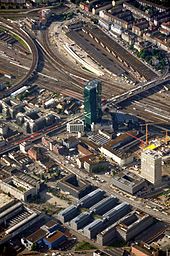
Switzerland is home to several large multinational corporations. The largest Swiss companies by revenue are Glencore, Gunvor, Nestlé, Novartis, Hoffmann-La Roche, ABB, Mercuria Energy Group and Adecco. Also notable are UBS AG, Zurich Financial Services, Credit Suisse, Barry Callebaut, Swiss Re, Tetra Pak and The Swatch Group. Switzerland is ranked as having one of the most powerful economies in the world.
Switzerland's most important economic sector is manufacturing. Manufacturing consists largely of the production of specialist chemicals, health and pharmaceutical goods, scientific and precision measuring instruments and musical instruments. The largest exported goods are chemicals (34% of exported goods), machines/electronics (20.9%), and precision instruments/watches (16.9%). Exported services amount to a third of exports. The services sector – especially banking and insurance, tourism, and international organisations – is another important industry for Switzerland.
Around 3.8 million people work in Switzerland; about 25% of employees belonged to a trade union in 2004. Switzerland has a more flexible job market than neighbouring countries and the unemployment rate is very low. Unemployment rate increased from a low of 1.7% in June 2000 to a peak of 4.4%, as of December 2009. Population growth from net immigration is quite high, at 0.52% of population in 2004. Foreign citizen population is 21.8% as of 2004, about the same as in Australia. GDP per hour worked is the world's 17th highest, at 27.44 international dollars in 2006.
Switzerland has an overwhelmingly private sector economy and low tax rates by Western World standards; overall taxation is one of the smallest of developed countries. Switzerland is a relatively easy place to do business, currently ranking 28th of 178 countries in the Ease of Doing Business Index. The slow growth Switzerland experienced in the 1990s and the early 2000s has brought greater support for economic reforms and harmonization with the European Union. According to Credit Suisse, only about 37% of residents own their own homes, one of the lowest rates of home ownership in Europe. Housing and food price levels were 171% and 145% of the EU-25 index in 2007, compared to 113% and 104% in Germany.
Agricultural protectionism—a rare exception to Switzerland's free trade policies—has contributed to high food prices. Product market liberalisation is lagging behind many EU countries according to the OECD. Nevertheless, domestic purchasing power is one of the best in the world. Apart from agriculture, economic and trade barriers between the European Union and Switzerland are minimal and Switzerland has free trade agreements worldwide. Switzerland is a member of the European Free Trade Association (EFTA).
Education and science
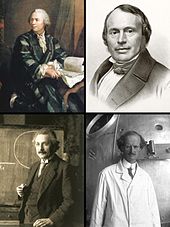
Leonhard Euler (mathematics)
Louis Agassiz (glaciology)
Auguste Piccard (aeronautics)
Albert Einstein (physics)
Education in Switzerland is very diverse because the constitution of Switzerland delegates the authority for the school system to the cantons. There are both public and private schools, including many private international schools. The minimum age for primary school is about six years in all cantons, but most cantons provide a free "children's school" starting at four or five years old. Primary school continues until grade four, five or six, depending on the school. Traditionally, the first foreign language in school was always one of the other national languages, although recently (2000) English was introduced first in a few cantons.
At the end of primary school (or at the beginning of secondary school), pupils are separated according to their capacities in several (often three) sections. The fastest learners are taught advanced classes to be prepared for further studies and the matura, while students who assimilate a little bit more slowly receive an education more adapted to their needs.
There are 12 universities in Switzerland, ten of which are maintained at cantonal level and usually offer a range of non-technical subjects. The first university in Switzerland was founded in 1460 in Basel (with a faculty of medicine) and has a tradition of chemical and medical research in Switzerland. The biggest university in Switzerland is the University of Zurich with nearly 25,000 students. The two institutes sponsored by the federal government are the ETHZ in Zurich (founded 1855) and the EPFL in Lausanne (founded 1969 as such, formerly an institute associated with the University of Lausanne) which both have an excellent international reputation.
In addition there are various Universities of Applied Sciences. In business and management studies, University of St. Gallen, (HSG) and International Institute for Management Development (IMD) are the leaders within the country and highly regarded internationally. Switzerland has the second highest rate of foreign students in tertiary education, after Australia.
As might befit a country that plays home to innumerable international organizations, the Graduate Institute of International and Development Studies, located in Geneva, is not only continental Europe's oldest graduate school of international and development studies, but also widely believed to be one of its most prestigious.
Many Nobel prizes were awarded to Swiss scientists, for example to the world-famous physicist Albert Einstein in the field of physics who developed his Special relativity while working in Bern. More recently Vladimir Prelog, Heinrich Rohrer, Richard Ernst, Edmond Fischer, Rolf Zinkernagel and Kurt Wüthrich received Nobel prizes in the sciences. In total, 113 Nobel Prize winners in all fields stand in relation to Switzerland and the Nobel Peace Prize was awarded nine times to organisations residing in Switzerland.

Geneva and the nearby French department of Ain co-host the world's largest laboratory, CERN, dedicated to particle physics research. Another important research centre is the Paul Scherrer Institute. Notable inventions include lysergic acid diethylamide (LSD), the scanning tunneling microscope (Nobel prize) and Velcro. Some technologies enabled the exploration of new worlds such as the pressurized balloon of Auguste Piccard and the Bathyscaphe which permitted Jacques Piccard to reach the deepest point of the world's oceans.
Switzerland Space Agency, the Swiss Space Office, has been involved in various space technologies and programs. In addition it was one of the 10 founders of the European Space Agency in 1975 and is the seventh largest contributor to the ESA budget. In the private sector, several companies are implicated in the space industry such as Oerlikon Space or Maxon Motors who provide spacecraft structures.
Switzerland and the European Union
Switzerland voted against membership in the European Economic Area in a referendum in December 1992 and has since maintained and developed its relationships with the European Union (EU) and European countries through bilateral agreements. In March 2001, the Swiss people refused in a popular vote to start accession negotiations with the EU. In recent years, the Swiss have brought their economic practices largely into conformity with those of the EU in many ways, in an effort to enhance their international competitiveness. The economy has been growing most recently at around 3% per year. Full EU membership is a long-term objective of some in the Swiss government, but there is considerable popular sentiment against this supported by the conservative SVP party. The western French-speaking areas and the urban regions of the rest of the country tend to be more pro-EU, however with far from any significant share of the population.
The government has established an Integration Office under the Department of Foreign Affairs and the Department of Economic Affairs. To minimise the negative consequences of Switzerland's isolation from the rest of Europe, Bern and Brussels signed seven bilateral agreements to further liberalise trade ties. These agreements were signed in 1999 and took effect in 2001. This first series of bilateral agreements included the free movement of persons. A second series covering nine areas was signed in 2004 and has since been ratified. The second series includes the Schengen Treaty and the Dublin Convention. They continue to discuss further areas for cooperation.
In 2006, Switzerland approved 1000 million francs of supportive investment in the poorer Southern and Central European countries in support of cooperation and positive ties to the EU as a whole. A further referendum will be needed to approve 300 million francs to support Romania and Bulgaria and their recent admission. The Swiss have also been under EU and sometimes international pressure to reduce banking secrecy and to raise tax rates to parity with the EU. Preparatory discussions are being opened in four new areas: opening up the electricity market, participation in the European GNSS project Galileo, cooperating with the European centre for disease prevention and recognising certificates of origin for food products.
On 27 November 2008, the interior and justice ministers of European Union in Brussels announced Switzerland's accession to the Schengen passport-free zone from 12 December 2008. The land border checkpoints will remain in place only for goods movements, but should not run controls on people, though people entering the country had their passports checked until 29 March 2009 if they originated from a Schengen nation.
Energy, infrastructure and environment
Electricity generated in Switzerland is 56% from hydroelectricity and 39% from nuclear power, resulting in a nearly CO2-free electricity-generating network. On 18 May 2003, two anti-nuclear initiatives were turned down: Moratorium Plus, aimed at forbidding the building of new nuclear power plants (41.6% supported and 58.4% opposed), and Electricity Without Nuclear (33.7% supported and 66.3% opposed).
The former ten-year moratorium on the construction of new nuclear power plants was the result of a citizens' initiative voted on in 1990 which had passed with 54.5% Yes vs. 45.5% No votes. A new nuclear plant in the Canton of Bern is presently planned. The Swiss Federal Office of Energy (SFOE) is the office responsible for all questions relating to energy supply and energy use within the Federal Department of Environment, Transport, Energy and Communications (DETEC). The agency is supporting the 2000-watt society initiative to cut the nation's energy use by more than half by the year 2050.
On 25 May 2011 the Swiss government announced that it plans to end its use of nuclear energy in the next 2 or 3 decades. "The government has voted for a phaseout because we want to ensure a secure and autonomous supply of energy", Energy Minister Doris Leuthard said that day at a press conference in Bern. "Fukushima showed that the risk of nuclear power is too high, which in turn has also increased the costs of this energy form." The first reactor would reportedly be taken offline in 2019 and the last one in 2034. Parliament will discuss the plan in June 2011, and there could be a referendum as well.
The most dense rail network in Europe of 5,063 km (3,146 mi) carries over 350 million passengers annually. In 2007, each Swiss citizen travelled on average 2,103 km (1,307 mi) by rail, which makes them the keenest rail users. The network is administered mainly by the Federal Railways, except in Graubünden, where the 366 km (227 mi) narrow gauge railway is operated by the Rhaetian Railways and includes some World Heritage lines. The building of new railway base tunnels through the Alps is under way to reduce the time of travel between north and south through the AlpTransit project.
Swiss private-public managed road network is funded by road tolls and vehicle taxes. The Swiss autobahn/autoroute system requires the purchase of a vignette (toll sticker)—which costs 40 Swiss francs—for one calendar year in order to use its roadways, for both passenger cars and trucks. The Swiss autobahn/autoroute network has a total length of 1,638 km (1,018 mi) (as of 2000) and has, by an area of 41,290 km2 (15,940 sq mi), also one of the highest motorway densities in the world. Zurich Airport is Switzerland's largest international flight gateway, which handled 22.8 million passengers in 2010. The other international airports are Geneva Airport (11.8 million passengers), EuroAirport Basel-Mulhouse-Freiburg which is located in France, Bern Airport, Lugano Airport, St. Gallen-Altenrhein Airport and Sion Airport.
Switzerland has one of the best environmental records among nations in the developed world; it was one of the countries to sign the Kyoto Protocol in 1998 and ratified it in 2003. With Mexico and the Republic of Korea it forms the Environmental Integrity Group (EIG). The country is heavily active in recycling and anti-littering regulations and is one of the top recyclers in the world, with 66% to 96% of recyclable materials being recycled, depending on the area of the country.
In many places in Switzerland, household rubbish disposal is charged for. Rubbish (except dangerous items, batteries etc.) is only collected if it is in bags which either have a payment sticker attached, or in official bags with the surcharge paid at the time of purchase. This gives a financial incentive to recycle as much as possible, since recycling is free. Illegal disposal of garbage is not tolerated but usually the enforcement of such laws is limited to violations that involve the unlawful disposal of larger volumes at traffic intersections and public areas. Fines for not paying the disposal fee range from CHF 200–500.
Switzerland also has internationally the most efficient system to recycle old newspapers and cardboard materials. Publicly organised collection by volunteers and economical railway transport logistics started as early as 1865 under the leadership of the notable industrialist Hans Caspar Escher (Escher Wyss AG) when the first modern Swiss paper manufacturing plant was built in Biberist.
Demographics
Switzerland lies at the crossroads of several major European cultures that have heavily influenced the country's languages and culture. Switzerland has four official languages: principally German (65.6% total population share, with foreign residents; 73.3% of residents with Swiss citizenship, in 2000); French (22.8%; 23.4%) in the west; Italian (8.4%; 6.1%) in the south. Romansh (0.6%; 0.7%), a Romance language spoken locally in the southeastern trilingual canton of Graubünden, is designated by the Federal Constitution as a national language along with German, French and Italian (Article 4 of the Constitution), and as official language if the authorities communicate with persons of Romansh language (Article 70), but federal laws and other official acts do not need to be decreed in this language. The federal government is obliged to communicate in the official languages, and in the federal parliament simultaneous translation is provided from and into German, French and Italian.
The German spoken in Switzerland is predominantly a group of Alemannic dialects collectively known as Swiss German, but written communication typically use Swiss Standard German, while the majority of radio and TV broadcast is now in Swiss German as well ( diglossic usage of a language). Similarly, there are some dialects of Franco-Provençal in rural communities in the French speaking part, known as "Suisse romande", called Genevois, Vaudois, Valaisan, Jurassien, Fribourgeois, Neuchâtelois, and in the Italian speaking area, Ticinese (a dialect of Lombard). Moreover, the official languages (German, French and Italian) borrow some terms not understood outside Switzerland, i.e. terms from other languages (German Billette from French), from similar term in another language (Italian azione used not only as act but also as discount from German Aktion). Learning one of the other national languages at school is obligatory for all Swiss, so many Swiss are supposed to be at least bilingual, especially those belonging to minorities.
Resident foreigners and temporary foreign workers make up about 22% of the population. Most of these (60%) are from European Union or EFTA countries. Italians are the largest single group of foreigners with 17.3% of total foreign population. They are followed by Germans (13.2%), immigrants from Serbia and Montenegro (11.5%) as well as Portugal (11.3%). Immigrants from Sri Lanka, most of them former Tamil refugees, are the largest group among people of Asian origin. Additionally, a 2008 study showed that 30.6% of the Swiss permanent resident population aged 15 or over, i.e. 1,965,000 persons, had an immigration background. A third of this population (651,000) have Swiss citizenship. Four fifths of persons with an immigration background are themselves immigrants (first generation of foreigners as well as native-born and naturalized Swiss citizens), whereas one fifth were born in Switzerland (second-generation foreigners as well as native-born and naturalized Swiss citizens). In the 2000s, domestic and international institutions expressed concern about what they perceived as an increase in xenophobia, particularly in some political campaigns. In reply to one critical report the Federal Council noted that "racism unfortunately is present in Switzerland", but stated that the high proportion of foreign citizens in the country, as well as the generally unproblematic integration of foreigners", underlined Switzerland's openness.
Health
Swiss citizens are universally required to buy health insurance from private insurance companies, which in turn are required to accept every applicant. While the cost of the system is among the highest, the system compares well with other European countries in terms of health outcomes, so patients are largely satisfied with it. In 2006 life expectancy at birth was 79 years for men and 84 years for women. It is among the highest in the world. However, spending on health is particularly high, with 11.5% of GDP (2003) and, from 1990, a steady increase is observed, reflecting the high prices of the services provided. With aging populations and new healthcare technologies, health spending will likely continue to rise.
Urbanization
Between two thirds and three quarters of the population live in urban areas. Switzerland has gone from a largely rural country to an urban one in just 70 years. Since 1935 urban development has claimed as much of the Swiss landscape as it did during the previous 2,000 years. This urban sprawl does not only affect the plateau but also the Jura and the Alpine foothills and there are growing concerns about land use. However from the beginning of the 21st century, the population growth in urban areas is higher than in the countryside.
Switzerland has a dense network of cities, where large, medium and small cities are complementary. The plateau is very densely populated with about 450 people per km2 and the landscape continually shows signs of man's presence. The weight of the largest metropolitan areas, which are Zurich, Geneva– Lausanne, Basel and Bern tend to increase. In international comparison the importance of these urban areas is stronger than their number of inhabitants suggests. In addition the two main centers of Zurich and Geneva are recognized for their particular great quality of life.
Religion
Switzerland has no official state religion, though most of the cantons (except Geneva and Neuchâtel) recognize official churches, which are either the Catholic Church or the (Protestant) Swiss Reformed Church. These churches, and in some cantons also the Old Catholic Church and Jewish congregations, are financed by official taxation of adherents.
As of the 2010 census Christianity is the predominant religion of Switzerland, divided between the Catholic Church (38.8% of the population) and various Protestant denominations (30.9%). Geneva converted to Protestantism in 1536, just before John Calvin arrived there. Immigration has brought Islam (4.5%) and Eastern Orthodoxy (around 2%) as sizeable minority religions. As of the 2000 census other Christian minority communities include Neo- Pietism (0.44%), Pentecostalism (0.28%, mostly incorporated in the Schweizer Pfingstmission), Methodism (0.13%), the New Apostolic Church (0.45%), Jehovah's Witnesses (0.28%), other Protestant denominations (0.20%), the Old Catholic Church (0.18%), other Christian denominations (0.20%). Minor non-Christian minority groups are Hinduism (0.38%), Buddhism (0.29%), Judaism (0.25%) and "other religions" (0.11%). 4.3% did not make a statement. The 2010 Eurobarometer poll found 44% to be theist, 39% expressing belief in "a spirit or life force" and 11% atheist. Greeley (2003) found that 27% of the population does not believe in a God.
The country was historically about evenly balanced between Catholic and Protestant, with a complex patchwork of majorities over most of the country. One canton, Appenzell, was officially divided into Catholic and Protestant sections in 1597. The larger cities (Bern, Geneva, Zurich and Basel) used to be predominantly Protestant. Central Switzerland, as well as Ticino, is traditionally Catholic. The Swiss Constitution of 1848, under the recent impression of the clashes of Catholic vs. Protestant cantons that culminated in the Sonderbundskrieg, consciously defines a consociational state, allowing the peaceful co-existence of Catholics and Protestants. A 1980 initiative calling for the complete separation of church and state was rejected by 78.9% of the voters.
Culture
Three of Europe's major languages are official in Switzerland. Swiss culture is characterised by diversity, which is reflected in a wide range of traditional customs. A region may be in some ways strongly culturally connected to the neighbouring country that shares its language, the country itself being rooted in western European culture. The linguistically isolated Romansh culture in Graubünden in eastern Switzerland constitutes an exception, it survives only in the upper valleys of the Rhine and the Inn and strives to maintain its rare linguistic tradition.
Switzerland is home to many notable contributors to literature, art, architecture, music and sciences. In addition the country attracted a number of creative persons during time of unrest or war in Europe. Some 1000 museums are distributed through the country; the number has more than tripled since 1950. Among the most important cultural performances held annually are the Lucerne Festival, the Montreux Jazz Festival and the Locarno International Film Festival.
Alpine symbolism has played an essential role in shaping the history of the country and the Swiss national identity. Nowadays some concentrated mountain areas have a strong highly energetic ski resort culture in winter, and a hiking (wandering) or Mountain biking culture in summer. Other areas throughout the year have a recreational culture that caters to tourism, yet the quieter seasons are spring and autumn when there are fewer visitors. A traditional farmer and herder culture also predominates in many areas and small farms are omnipresent outside the cities. Folk art is kept alive in organisations all over the country. In Switzerland it is mostly expressed in music, dance, poetry, wood carving and embroidery. The alphorn, a trumpet-like musical instrument made of wood, has become alongside yodeling and the accordion an epitome of traditional Swiss music.
Literature
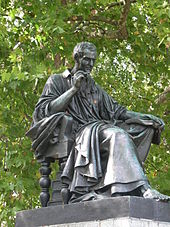
As the Confederation, from its foundation in 1291, was almost exclusively composed of German-speaking regions, the earliest forms of literature are in German. In the 18th century French became the fashionable language in Bern and elsewhere, while the influence of the French-speaking allies and subject lands was more marked than before.
Among the classics of Swiss German literature are Jeremias Gotthelf (1797–1854) and Gottfried Keller (1819–1890). The undisputed giants of 20th century Swiss literature are Max Frisch (1911–91) and Friedrich Dürrenmatt (1921–90), whose repertoire includes Die Physiker ( The Physicists) and Das Versprechen ( The Pledge), released in 2001 as a Hollywood film.
Prominent French-speaking writers were Jean-Jacques Rousseau (1712–1778) and Germaine de Staël (1766–1817). More recent authors include Charles Ferdinand Ramuz (1878–1947), whose novels describe the lives of peasants and mountain dwellers, set in a harsh environment and Blaise Cendrars (born Frédéric Sauser, 1887–1961). Also Italian and Romansh-speaking authors contributed but in more modest way given their small number.
Probably the most famous Swiss literary creation, Heidi, the story of an orphan girl who lives with her grandfather in the Alps, is one of the most popular children's books ever and has come to be a symbol of Switzerland. Her creator, Johanna Spyri (1827–1901), wrote a number of other books around similar themes.
Sports
Skiing, snowboarding and mountaineering are among the most popular sports in Switzerland, the nature of the country being particularly suited for such activities. Winter sports are practiced by the natives and tourists since the second half of the 19th century with the invention of bobsleigh in St. Moritz. The first world ski championships were held in Mürren (1931) and St. Moritz (1934). The latter town hosted the second Winter Olympic Games in 1928 and the fifth edition in 1948. Among the most successful skiers and world champions are Pirmin Zurbriggen and Didier Cuche.
Many Swiss are fans of football and the national team or ' Nati' is widely supported. Switzerland was the joint host, with Austria, of the Euro 2008 tournament. Many Swiss also follow ice hockey and support one of the 12 clubs in the League A, which is the most attended league in Europe. In 2009, Switzerland hosted the IIHF World Championship for the 10th time. It also became World Vice-Champion in 2013. The numerous lakes make Switzerland an attractive place for sailing. The largest, Lake Geneva, is the home of the sailing team Alinghi which was the first European team to win the America's Cup in 2003 and which successfully defended the title in 2007. Tennis has become an increasingly popular sport, and Swiss players such as Martina Hingis and Roger Federer have won multiple Grand Slams.

Motorsport racecourses and events were banned in Switzerland following the 1955 Le Mans disaster with exception to events such as Hillclimbing. However, this ban was overturned in June 2007. During this period, the country still produced successful racing drivers such as Clay Regazzoni, Sebastian Buemi, Jo Siffert and successful World Touring Car Championship driver Alain Menu. Switzerland also won the A1GP World Cup of Motorsport in 2007–08 with driver Neel Jani. Swiss motorcycle racer Thomas Lüthi won the 2005 MotoGP World Championship in the 125cc category.
Traditional sports include Swiss wrestling or " Schwingen". It is an old tradition from the rural central cantons and considered the national sport by some. Hornussen is another indigenous Swiss sport, which is like a cross between baseball and golf. Steinstossen is the Swiss variant of stone put, a competition in throwing a heavy stone. Practiced only among the alpine population since prehistoric times, it is recorded to have taken place in Basel in the 13th century. It is also central to the Unspunnenfest, first held in 1805, with its symbol the 83.5 kg stone named Unspunnenstein.
Cuisine
The cuisine of Switzerland is multi-faceted. While some dishes such as fondue, raclette or rösti are omnipresent through the country, each region developed its own gastronomy according to the differences of climate and languages. Traditional Swiss cuisine uses ingredients similar to those in other European countries, as well as unique dairy products and cheeses such as Gruyère or Emmental, produced in the valleys of Gruyères and Emmental. The number of fine-dining establishments is high, particularly in western Switzerland.
Chocolate had been made in Switzerland since the 18th century but it gained its reputation at the end of the 19th century with the invention of modern techniques such as conching and tempering which enabled its production on a high quality level. Also a breakthrough was the invention of solid milk chocolate in 1875 by Daniel Peter. The Swiss are the world's largest consumers of chocolate.
The most popular alcoholic drink in Switzerland is wine. Switzerland is notable for the variety of grapes grown because of the large variations in terroirs, with their specific mixes of soil, air, altitude and light. Swiss wine is produced mainly in Valais, Vaud ( Lavaux), Geneva and Ticino, with a small majority of white wines. Vineyards have been cultivated in Switzerland since the Roman era, even though certain traces can be found of a more ancient origin. The most widespread varieties are the Chasselas (called Fendant in Valais) and Pinot noir. The Merlot is the main variety produced in Ticino.


![Location of Switzerland (green)in Europe (dark grey) — [Legend]](../../images/915/91522.png)
